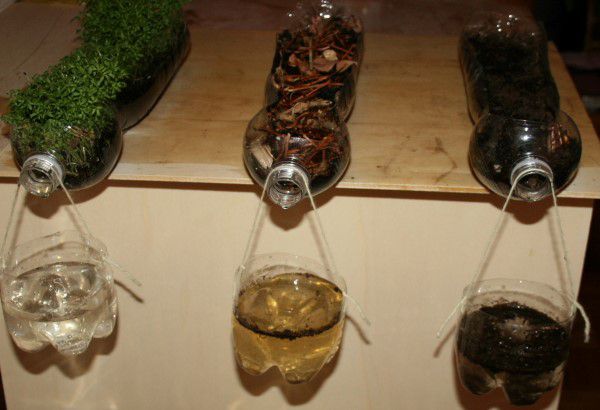Conservation Nation
Author
Published
1/23/2017
Target Grade Level / Age Range:
Grades 3-5
Time:
30 minutes of preparation a week before hand; 45 minutes
Purpose:
Students will learn about issues concerning soil and water and how farmers use science to help conserve these resources.
Materials:
- Deck of Conservation Nation playing cards
- Six empty water bottles
- Soil
- Fast-growing seeds, such as sunflowers, wildflowers, or herbs, OR transplanted growing plants
- A large piece of cardstock, plywood, or other sturdy material
- Water
- Natural soil residue such as twigs, bark, corn husks, stems, dried leaves, or woodchips\
- String
Vocabulary
- Runoff – the draining away of water from the surface of land
- Cover crop – a crop planted between spring planted crops (typically corn or soybeans) that is grown and tilled under to decrease erosion and improve nutrient uptake
- Erosion – the gradual wearing away of soil from land
- Waterways – grassy strips in fields where water can run without eroding the soil
- Conservation - preservation, protection, or restoration of the natural environment, natural ecosystems, vegetation, and wildlife.
Interest Approach or Motivator
Students will be initially engaged by a demonstration of water runoff from three different land scenarios. Then, they will work in groups to correctly sort water, soil, and wildlife habitat conservation practices by their quality.
- A week before the presenting the lesson, cut a two inch wide section that runs nearly the whole length of the bottle out of 3 of the water bottles. Keep one of the cut out sections.
- Superglue the three bottles, cut open side up, to a piece of plywood or cardstock. The lip and cap of the bottle should hang over the edge of the plywood, so caps can easily be taken on and off.
- Fill all three bottles with soil until about a centimeter or two below the opening in the top of the bottle.
- In the last bottle, plant the seeds or transplant the plants. Cover seeds with soil, water gently, and cover with the saved section of bottle.
- In the middle bottle, cover the soil with residue. Leave the first bottle bare.
- Cut the bottoms off of three other water bottles about 1/3 up the bottle. Punch two holes in each bottle bottom and run a long string through the holes. Hang the bottle bottoms from the caps of the bottles filled with soil.
- Once the planted plants have emerged from the soil and begun to grow, the demonstration is ready. Remove the caps from all the bottles.

- Gently pour water down the cut open section of the bottle in each bottle, starting with the bare soil. Have students observe the amount of soil that runs through the opening and into the hanging bottle bottoms. The bare soil should have the most runoff, and the bottle with the plants in it should have the least. Discuss with students why this happens and the importance of preventing it from happening.
Background – Agricultural Connections
For farmers, taking good care of the Earth is crucial. While every farmer is different, they all work to take care of the soil, water, and wildlife surrounding their farms. For livestock farmers, this means handling manure appropriately and taking care of pasture ground. For crop farmers, this could mean planting cover crops, establishing wildlife habitat, or implementing conservation tillage practices.
Procedures
- Distribute shuffled Conservation Nation cards to students in groups of four. Have them work together to sort water, soil and wildlife conservation practices into “Needs work” (poor), “Better” (okay), and “Best” (good) categories.
- Some cards are “Challenge!” cards. These should be included for upper elementary students. They can be left out for lower elementary students or added at the end of the activity for additional discussion.
- The group of students with the most cards sorted into the correct categories wins. Use the teacher key to check answers and for clarification.
- Review each conservation practice with the students to ensure comprehension.
- For practices that need work or could be better, have students brainstorm ways to improve the practices.
- Have the students complete the Conservation Nation worksheet to reflect on the activities in groups or individually.
Essential Files (maps, charts, pictures, or documents)
Did you know? (Ag facts)
- Farms provide habitat for many species of fish, birds, and prairie mammals.
Extension Activities
- Visit a local farm to see firsthand how farmers take steps to care for the Earth.
- Have students play “Go Fish” with the Conservation Nation Cards. Complete hands of Soil, Water, and Wildlife Conservation practices that are only helpful to the Earth.
Author(s)
Kelsey Fairve
Organization Affiliation
Iowa Agriculture Literacy Foundation
Agriculture Literacy Outcomes
- Identify land and water conservation methods used in farming systems (wind barriers, conservation tillage, laser leveling, GPS planting, etc.)
- Recognize the natural resources used in agricultural practices to produce food, feed, clothing, landscaping plants, and fuel (e.g., soil, water, air, plants, animals and minerals)
- Describe the importance of soil and water in raising crops and livestock.
Common Core Connections
- 3-5-ETS1-2: Generate and compare multiple solutions to a problem based on how well each is likely to meet the criteria and constraints of the problem.
- 4-ESS3-2: Generate and compare multiple solutions to reduce the impacts of natural Earth processes on humans.
- 5-ESS3-1: Obtain and combine information about ways individual communities use science ideas to protect the Earth’s resources and environment.
This work is licensed under a
Creative Commons Attribution 4.0 International License.
